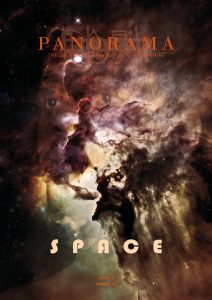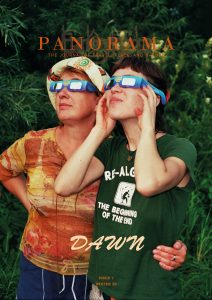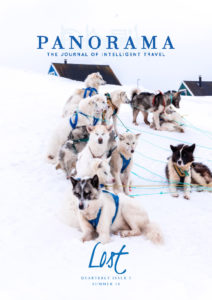My father’s property sat at the end of the newly cut Dream Farm Road—a steep rutted track through uncut forest, bordered by the Point Reyes National Seashore and untouched privately owned woodland. In the early 1970s, this was home. The two of us lived in a pair of illegal redwood cabins, banged up from ground to shingled roof over a few weekends by local friends. No electricity, no running water, no plumbing, it was the setting for the prolonged period of semi-camping that marked my early teen years on the western edge of northern California. I chopped firewood, I hauled water from a neighbour’s well, I flailed through a chaotic adolescence of hitchhiking, no high school, food stamps, barefoot ridge walks, and an unreliable single parent. There were few anchor points of regularity. One of them was dinner at twilight, cooked over an open fire, usually with whatever meat was cheapest at the local grocery store. Sometimes beef, sometimes shark. At the end of the month when the money ran out, steamed broccoli.
The wood in the fire, the stumps we sat on, the temperate rainforest of slender bay trees underlit by firelight, created a place that—for all its challenges—was received by my heart as home. I can still catch the memory scents of fern undergrowth, resinous herbal smoke, the iron tang of the meat, and the earth perfume of the loamy forest floor we had excavated around the cabins. The food always tasted of forest and flame. I also remember starting to get, well…angry. A lot.
My father was inclined to philosophical discussions. Between his serial romantic conquests, he saw it as his duty to make me think about Deep Things. Or maybe it was just his own favourite line of discussion. He played the guitar and had a voice of a professional singer, which was what he’d been when I was very young. We laughed a lot. This circle of us, warmed and lit in the fire, the wild world all around and the sky above the sweeping branches of the bay trees as they creaked and sang their own songs. We attributed my increasing combustibility to hormones, but my memory was still one of a warm relationship.
In spring we would revel in the lush explosion of wild irises and forget-me-nots that carpeted the forest floor in early spring, or the harvest of mushrooms after the latest downpour. Rain hit my wood-shingled roof, my front door opened into mud, I got drenched making my way along the narrow fern-lined path between my cabin and my father’s, and I started to suspect that the main reason I burned with so much anger was that my dad left me alone a lot and bossed me around when he was home.
When I was fifteen, my anger moved me into a cabin in central Inverness. If I was going to be alone, I figured, I might as well do it among other people while having central heating, running water, and lights I could illuminate with a wall switch. I got a job. I paid my rent. I took a high school equivalency test and then got myself enrolled at a community college. I thought of my relationship with my father as close, but fraught. He cared about me, but he was difficult and eccentric. Friends and boyfriends liked him; he was funny and charismatic and interested in them. When I went to visit him, and it was always me who made visits, we generally spent a lot of our time telling stories and laughing.
I grew up and held duality in my heart. There was the home of that fireside sanctuary beneath a bay laurel canopy, and there was my ever-present affront at my father’s actions, even from a distance. If he wasn’t overtly cruel, or malicious, or violent, he also wasn’t overtly interested or engaged.
Attentive readers might have caught that first whiff of smoke right about now. It took me much longer to discover my own subterranean embers.
Four decades and three countries later, I was living in France. Dad had been drifting away from what I thought of as the circle of us for a long time. I’d show up to redraw the circle, he would stand at the outer edge. I can’t explain why I kept coming back for more. But in 2019, his 80th birthday was approaching, and I wanted to celebrate with him. He’d moved south of the border to Baja many years earlier; I invited him to meet me near San Diego. I said my gift would be for him to invite old friends to a cluster of historical redwood cottages, and to party like it was 1976. He’d been raised near La Jolla; I was born there. At his request, the plan was to meet up the day after his birthday – he said he was busy with doctor’s appointments on the actual day. I’d been visiting my late mother’s side of the family in LA, and would make my way south on Highway 101 from Burbank to La Jolla.
In those forty years since I’d left the country, California fire season had grown like a wildfire itself to consume most of any year. As I navigated the 101, a cloud of smoke rolled across the 10-lane stretch of the Ventura Freeway like a gargantuan burning tyre, throwing black streamers and blinding the way ahead. The air reeked of smouldering rubber and hot solder. Traffic was coalescing and a chain of red lights settled into place ahead. News radio was warning people to avoid the 101 by then. There was a turn-off, and I took it.
I don’t know my way around Los Angeles all that well, and so when I found myself on a nice four-lane road headed away from the fire zone, I felt quite pleased with my own presence of mind. I thought I’d cut over the hills into central LA and pick my way south from there. There had been noisiness and annoyance all week from my father, my LA family had said they didn’t think I should go down. I was deeply unsettled. I hadn’t seen him much; his habits of half-truths and obfuscation had gotten worse. I hoped this visit would retrieve some of that home that I’d enshrined as truth in my personal history. On the road, I questioned why I was even going. Of course, I knew the answer: Duty and self-immolation, doing the ‘right’ thing to convince myself that nothing else could be done.
I was chewing over these thoughts, fanning my own flames and trying to douse them, while I drove.
The road narrowed at Mulholland Drive; I crested the ridge and descended into two-lane traffic down Laurel Canyon. Bumper-to-bumper now because I hadn’t been the only one with the stellar idea of escaping the smoke this way. Laurel Canyon is narrow and picturesque and famous and wealthy, and it didn’t take me long to realize it was also one of the prettiest urban fire traps you could wish for. As bad or worse than the freeway, where at least a body had a chance to run. I was feeling hemmed in on all sides, and not just by the canyon, the unfolding natural disasters, and the smoke. This wasn’t the circle I’d been seeking. It was like I was a heat-seeking creature, looking for ways to burn.
After cutting through West Hollywood, I aimed myself through Inglewood and hit the 405 south. The reliable Big Blue to the right of me, the volatile territory of my birth to the left. Sunny skies were visible in shreds between the haze of smoke that was standing in for coastal fog. There were major and minor wildfires across the state, the Tick, Kincade, and Saddleridge fires were raging, and spiky blazes everywhere got snuffed but not before billowing more smoke. If I believed in that kind of thing, I would have thought that fate was trying to tell me I was heading towards disaster. But then, that would have put me and a few million other Californians on the wrong road.
I did wonder if I was still inviting myself to the wrong party and creating my own familiar pyre of familial sacrifice.
And then, lo, what a bright flame it turned out to be! The cabins I’d rented were a stone’s throw from the rocky coves of the La Jolla shoreline. We could hear the seals barking out on Seal Beach.
Of the many unlearned lessons I needed to grasp on this visit, there’s one that’s illustrative of how my father functioned: He had invited all the people he wanted to impress—a business partner, an estranged but sought-after spouse, the friends—for the night prior to my arrival. This was his actual birthday. Me, he’d told me he wouldn’t be able to arrive until the following day. Hence my arrival via smoke signal. Them, he’d told that I wasn’t available until the following day. He wanted to look like the host at the cabins that I had booked. No wonder the hotel had been calling the previous day, demanding credit card verification—he’d extended my booking by an extra night without telling me.
Over the following two days, I watched him alternate between warm friendliness to me when others were around, and disapproving dismissal when it was the two of us. A long solo walk on the beach revealed what I’d been unwilling to see: Those absences of my youth hadn’t been by accident. They’d been physical manifestations of our relationship in real time. That time spent around the cooking fire had been two people, each of them alone in a circle of light, but only one of them knew it. That had been my ember of rage that never went out. When the guests had all left, I told him: All I’ve ever done is show up. It’s fine if you want to take that for granted, but I’m done assuming there’s anything I should be showing up for.
His comment: Impressive. It must be hard for you to say that.
My California youth and that of the generation before me, and maybe the one immediately after, was a daydream of mild rainy winters and warm summers, of rain that would always show up at some point, of spring-green hills that slowly turned that famous gold, and air and salt and sun. What we knew about Northern California back then was that fires came, and fires went, but the rains would come and the world would turn green again. Forces were already in motion that put all these assumptions to the lie, but we either ignored or denied them.
I felt the same for most of my life about my father—there would be a spring blossoming again, someday, that would put out any lurking flames. The day I awoke from my dreams of Dream Farm Road, half a century after I’d started conjuring them, was the day I could put out the rage.
For two weeks in 1976, my view from my single-room wood cabin in West Marin, California was this: A blue cathedral of coastal sky, the morning fog receding in tatters, and the Running Fence, a brief art installation that ribboned in late summer sunlight on the other side of Tomales Bay. The massive environmental art piece by Christo and Jean-Claude undulated along 25 miles long (39.4 km) of rolling California hills, a fluid line of the entire state’s bleached sheets strung end-to-end right to infinity. Running Fence highlighted aspects of a landscape in unexpected ways, and its ephemerality was part of its message about boundaries and fences.
Here’s what I know now: For decades, I was certain that I viewed Running Fence, a glistening trail left by a house-sized snail, from my cabin window. Looking at an archival map of the Fence, though, I later realized that I couldn’t possibly have seen it from that vantage point. Running Fence was too far away and behind too many hills. I must have driven out there with my father, or with friends, to view it.
How could I not remember that?
I also know how much of that my fire circle of home was a fabrication just as illusory as having seen Running Fence, but much longer lived. My personal fiction ribboned through my heart and identity. Like the Fence, even standing right next to it, I could only see most of it at a distance. It outlined the landscape of how I saw myself.
How the hills have shifted now that it’s gone.











